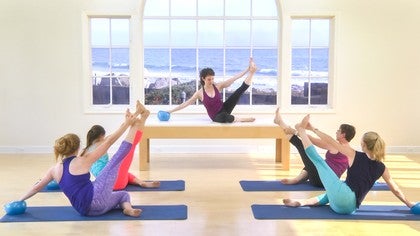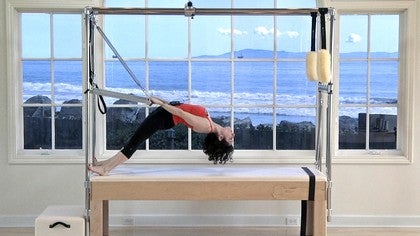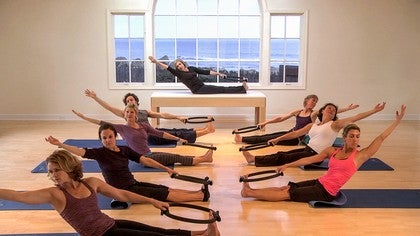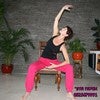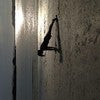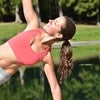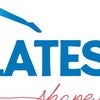Description
About This Video
Transcript
Read Full Transcript
Hello, I'm Rebecca Rotstein. And today we're going to do a mat class with some deflated balls and we're going to do a little bit with some spirals as well. So as we begin, I'd like you to lie down on your backs and place the ball underneath your sacrum. So you're going to have it in this area right here. And actually, you know what, I take that back. You're going to go even a little bit lower because it's going to be moving side to side on the butt cheeks. So we're going to start off a little bit slowly. As you know, I tend to like to get a little bit of embodiment first and then work you.
So you're going to shift and uh, let your, your hips move side to side, keeping your knees in the same place though. So that's the key. You're going to just go side and side and side and side and just observe where you might have a little restriction. So this might help you out where you have a little bit of tightness through one it band. You might find that if you have some tightness in the lower abdomen, in one area or through a hip, that it might help you with that. So just start getting some movement.
It's almost like we're just lubricating the joints. All right, now we're going to place reposition the ball. Let's, let's see underneath your left buttock. So we're going to start moving the opposing hip and I'm going to give you three different ways to do this. So the first way we're going to do, so it's underneath the left buttock. And first you're going to drop the right hip down. So the right butt cheek is going to drop down into the ground.
We're going to first concentrate on the right glute, so you're going to activate that right glute to allow that right hip to level up into the air. So it's the same height as the other one. So let your right buttock engage to lift it up into the air. And again, let it drop down and rise back up. Ladies, I'd like you to be sure that your feet are hip distance apart. And I'm sorry I didn't state that at the beginning and lower and rise and last time, lower and rise. Now we're going to have a different focus this time I want to give an abdominal focus. So if you had a string or let's say an elastic that was connecting from your left lower rib to your right hip, it's going to stay on stretch right now. It's on stretch.
And now you're going to let it shorten and that's going to bring your right hip up to the same height. [inaudible] and I are going to let it stretch again. Is that right? Hip drops moving away from the left lower rib and let it rise back up. And again, [inaudible] lengthening, I guess to the stretch and arising and once more and rising. Now we're going to have a different focus.
We're going to focus on the hip joint itself. So usually when we're moving, we're moving or thighbone within the socket. Now we're gonna move the socket around the thighbone. So you're going to drop your right hip down so that pelvis is moving over the thighbone and then it's going to rise back up. So notice your thigh bone is not moving. [inaudible] you're moving the socket and the whole pelvis around that stable thighbone. So again, the way that you embody it and the way you can see, you can see it might give you a different experience and engagement as well in your body and last time and rising back up. Let's try it on the other hip.
It's a really, really nice way to balance out the body before you start working intensely. So we now have it underneath the right buttock and we're going to let the left buttock drop down to the ground and we're gonna engage that left glute to help it rise back up. And again, juror up. So it starts to stretch and then the fibers of the muscles start to contract and they start to release and they start to contract. And once more releasing and contracting. Pause here.
Now we're gonna think about that elastic that we were talking about before. So now you've got the elastic going from the lower right ribs down to the left hip and they're going to lengthen away from each other and then they're going to shorten. And that's going to be an abdominal focus now. So if you want to think about it, I'm getting you a sling system connectivity between your internal and external obliques that actually work together functionally. So we're preparing our body for the exercises that we're going to be doing shortly and lowering and rising. So the rising is the shortening of that abdominal connection and the lowering of the lengthening and the shortening occurs in the rising last time.
Lower it back down. Now let's think about that thigh bone within the socket. So we're gonna move the socket around the thigh bone and then we're going to drop that hip and returned to that starting position. So the thighbone moves around the ball, I just said that wrong. The socket moves around the ball and then the socket moves again to drop.
And once more the socket moves around the ball, the ball being the head of the, the thigh bone, the femur. And one last time, going up and down and relax. Now let's reposition the ball so that it's directly underneath the sacred, the sacred being right here and below the quote low back area. It should feel kind of Nice. Breathe in and your ribs to Hammock for a second. So take away the tension in your back.
First activity that I'd like you to do is to allow your knees to sway to one side. Try not to let your whole spine twist though, and return back to center. Let your knees sway to the other side so a little knee drops and back to center. Now the challenge is you're on the instability or you have the unstable surface of a ball. So if you don't get any kind of lower abdominal connection, you're going to fall right off it and returning. And let's do one more set to each side. Yes. And it allows you to get a release through the tightness through one of your hips. And then go to the second side and return. Now fold your knees into your chest.
[inaudible] let's do a couple knee folds here. So you're gonna lower one thigh partway down, or even all the way down to the ground and return back up. So this is a nice way to reeducate your so as muscle and the whole Elio, so as muscle, which might be in a locked, long or locked short position, creating some, some strain on your back. So let's exhale as you lower. Inhale as you rise and everybody paused at the top and let's do it in sync together. Exhale, lower one. Inhale, slowly returned back up. Exhale, lower the other one. Inhale, slowly return back up.
And notice how it just folds with ease and returning back up. And last one. Good and returning back up. We're going to go into single leg circles here. So you're going to reach one foot up to the ceilings. Have everybody with their right foot.
So funny how everybody always goes for the right first. So we're going to cross our midline and circle down, around and up. So our single led circles are a little bit more challenging because again, we have the instability of the ball to control and around and up. Keep them smaller. If you find you're wiggling around too much, make them a little bit bigger. If you find that you want a little more challenge, I notice how little effort you could use, so maybe you're overworking in a way that's unnecessary.
And let's reverse. Let's go the other direction. Lowering down around an up, down, around and up, down, around and up again, soft of the chest. There we go. And now let's try the second side and we lower down around and up. So small circles and down. And then if you want, increase the size of your circle so you can increase the of motion to make it a little bit more challenging. For Myself, who has a lot of inherent instability, this feels really, really comforting to my back and it's very reassuring to my spine as well, and it helps me feel that connection that I don't always feel right away if I were to go straight into the exercise on its own and relax. So you've got the ball underneath your hips here, this point, both knees into your chest, lift both feet up to the ceiling. Let's remove the ball and you're going to slow Lee, lower your spine down and continue that motion through the legs as they continue going and going and going. And now like a teeter totter, you're going to cervical, nod and curl your chin.
And then as you keep lowering your legs, then you now have that teeter totter of your head coming up. Let's go into the a hundred here and inhale, two, three, four, five and exhale. Two, three, four, five and inhale, two, three, four, five. Squeeze your heels together. And he'll two, three, four, five. Exhale, two, three, four, five in, inhale, and exhale, two, three, four, five and eight. Heel, two, three, four, five in XL, two, three, four, five.
Last time. [inaudible] cell two, three, four, five. And relax. Lower your feet all the way down. Lift your hands up overhead, come back into a parallel position, circle your arms around. So we're going to do a roll up with an open arm circle like this, and then ruling up and inhale. Lift the hands all the way up and start rolling down and lift the hands all the way up overhead.
So it's almost like we get an extra motion through the arms and dropping the Chin and rolling up. Inhale, lift the arms all the way up overhead and start lowering yourself through your spine as your arms open. Good. Repeat that as your arms come around and they start to reach forward all the way up over her head and start lowering yourself down, opening your arms, bring your arms all the way down to the hips in one more circle around and rising up. And then we start to lower the arms and lower ourselves all the way down. Grab your ball. We're not going to place that ball in what would be the lower rib area so you don't want the ball to be too inflated because think about it, the more inflated is the higher it's gonna make you, which might be appropriate.
But I'll warn you, I did this trying it out the other day and my upper abs are still sore two days later. So that's for your benefit that we're doing it like this. Pull your knees into your chest. We're going to do a little bit of our ab series in this range today. So you're going to pull for single leg stretch. Let's pull our left knee into our chest and switch and switch and switch.
Speed it up and switch and switch and [inaudible], which you might want your, your ball a little bit higher up on your back just so it doesn't strain your upper abs too much. And switch and switch and switch and switch. And Five, four, three, two, one. Relax. We now go into our double leg stretch, so we're going to lengthen both our knees as well as our elbows and pull and reach and pull and squeeze and reach and pull and reach and pull and reach and pull a pause for our scissors. Pull one leg toward you. Now you'll notice that, oh, it's so much easier to get my face toward my, my thigh here, but I want you to really think about the lengthening as you shoot your legs like scissors and pull, pull switch. Paul Paul, switch, Paul Paul, switch, Paul Paul, switch Paul Paul, switch soft shoulders. So it's almost like you could remove your hands. [inaudible] switch, pull, pull, switch, poeple switch, pull and relax. Lower your feet, lean all the way back, kind of luxuriate in an opening your elbows out to the sides, spreading your hands wide, opening your knees, pulling your knees together, dropping your Chin and rising back up. Let's repeat that movement. So you're going to lean all the way back. You're going to open your arms, push your palms away from one another. Open the knees, circle the arms around, knees together.
Drop Your Chin and arise up once more. Lean all the way back. Opening your arms. I admit it's a little swan lake, but that's okay. And he's open. Knees closed. Circle the arms. Drop the Chin and rise up. Now we're going to go into what I've been playing with that I like.
With bicycle, I'm doing a lot of bicycle these days, so pull your knees into your chest. You're going to do a bicycle here at Loring, one foot down, and actually open your arms a little more to the sides. Now watch this. Let's add in a little twist so that as you lower that leg, it crosses over your midline and then you go to the other side. Anybody feel their abdominals? Make sure that you're not straining your neck so that your gaze is looking forward. As we were talking about earlier today, and one more each side, and let yourself lean back. And again, luxury once and rise up. Let's go into almost a roll up. So we sit nice and tall. Bend your knees. I'd like everybody to face inward today. Bend your knees, see if you could lift your hips so that you lower yourself onto your stomach without, without the bother in front of you and your boss is going to be at your side.
So we're going to add in today to our swan dive, a little variation, again, bringing the twist theme, but with some a Lavon, Bertini UF. So first thing forehead will be face down as I think about how to say that your forehead will be phased down and your feet are going to be hip distance apart. Actually, maybe even a little bit more than hip distance apart. So the first part for this extra role that we're going to initiate is from the right foot. You're going to start to lift it up toward your midline and notice how you could go even a little higher if your back permits it so that the hip starts to lift and back down. Your hip might not be ready for it yet.
So stay within a pain free range. Now let's try the left one. So it comes and lift toward the midline and then the glute starts to lift you up as well and back down. Let's repeat that. So the right leg rises and starts to come toward the midline here. Yes. And then back down and then the left one rises and you get not only the glute, but you get a little bit of your external rotator, which often is dormant in people and I think is part of the problem, which leads to the back and hip pain.
Now let's go into a swan dive. Let's forget about that for a moment cause we're going to layer it in a moment. So we start by lifting both feet together and then we lower both feet. And as we lower both feet, the hands start to slide up and then we dive. So your hands slide downward and your feet rise and your feet lower and your hands slide to rise.
Nice ladies n roll forward. It's not really rural, but slide forward and rise back up. Let's do one more here and slide. So he got a lot of glute going on and start Verizon. Let's combine these movements now. So as we lower down, let's just do our right hip and it might be that you could even let the hip rise in addition to just the foot. So I said that wrong. It's the foot that rises, but the hip might even twist as well. And then you come up for the front part of Your Swan does and as you lower down the left foot and the left hip might even cross over a little bit.
So you get a twist and then you rise and you dive. That's it. And you arise and you dive with the twist and you rise up in the center. And everybody. Pull yourselves inward now. So you're gonna have your forums on the ground.
Pull yourselves in if you can so that you sit back for a moment. I know it dawned on me that you're probably not able to pull and drag everything, and so I want you to feel that stretch on your low backs for a moment and come forward into a single leg kick. So return to that starting position. Make a little fists with your hands. Some of you may know that I am a big, a bit of a stickler on this. I'm not a fan of pulling your elbows in toward your chest. I find that that tends to increase the curvature in the low back, which is not my goal. Instead, I want you to push your elbows forward and notice how that gives you a connection into the whole shoulder girdle. Now stay lifted.
Kick your right heel to your butt twice. Kick, kick, lower down, kick kick, lower down, kick, kick, lower down, kick, kick, lower down point, flex, lower point, flex, lower pause. Notice if you've sunk you haven't. You guys are pretty good, but a little body check and kick, kick and lower kick, kick, lower kick, kick, lower kick, kick, lower touch your toes and Lyft, little plank, lower knees, stay lifted, kick, kick, lower kick, kick, lower kick, kick, lower kick, kick lower, drop your hips and allow yourselves to roll onto your side. On our side, I want you to place the role under, and I'm trying to think of the safest way on here so I don't fall. Plays the role underneath your rib cage, so it's almost like the side of your Scapula, your shoulder blade. And I want you to stay here for a moment, feel how nice that is, and you're going to reach that top arm for while you reach the top foot back.
Now bend the knee and here's what we come into, some of our spiral and roll around so that you circle that top arm around while that taught me reaches forward and then you go the opposite direction. Does that make sense? And it's part of a natural movement pattern as you feel that twist and spiral. But it's harder than it would be if you were just on the ground. So you have to prevent yourself from falling, rolling off it and return. All right, enough for the luxuriating. Now we get to work.
So rest your head on your, on your arm and lift your hips up and down. No hand and up and up and up. And now you can rest your arm. Let's see, h I guess I should say you should prop your head in your hand but I hardly want you to use it and up and down and up and down. Now lift up with that top foot and now you can rest your head in your hands so that you have just a little bit of less strain on your neck and kick forward and go back and kick forward. Good and reach back and I want you to be careful that you stay stacked and your your range of motion.
Maybe just a little bit limited [inaudible] and two more
Nothing above the ball is touching the ground. And you're going to do small adductor circles here and 10, nine, eight feel the connection through the pelvis. Seven, six, five, four, three, two, one. Reverse. Ten nine, eight, seven good. Six five, four, three, two, one. And going back to what we did at the very beginning, get one more bit of rotation, circling the arm around and lift your hips. You might need to move the ball as you roll over onto side too. I'm going to twist so that I can face all of you to know we have the ball underneath our right ribs or actually you guys are facing different directions.
So one set of ribs, which is really underneath the Scapula. No, no, it's fine. I just realized that, that uh, some people have it under the left, some people under there, right? It's totally normal. It's just my own dyslexia for a moment. So you're gonna rest your head on your arm here for a second. Now slide that top arm for a while. That top foot goes behind you. [inaudible] take a deep breath in. Exhale, bend that top knee in and you're going to circle that top arm around. Now again, you don't want to fall all the way off the ball, so see what adjustments you might have to make and circle around to return to the starting position.
So come back to the starting position here with yes, with that [inaudible] I called it the diagonal stretch and bend the top knee in. Now we'll notice what would happen if you made it a little bit harder by lifting your head off the ground. Yes and sliding that arm around. So it makes you work your neck a little bit more so that when your head hovers above the ground, the deep neck flexors work and turn the other direction. So you go back to the starting positions, top foot slides behind you.
Inhale there and exhale. Bend the knee in less time. So if I keep my head hovering above the ground actually works through the neck a little bit more and return and start to that beginning position. Now place the bottom arm underneath your head and we're going to do a little bit with our kicks here. So you're going to go front, back and pointing the toes behind you. [inaudible] and top and behind your head and reaching the foot behind you. Good. Keep going. And two more.
Did I do this on the for side? I'm almost forgetting. I'm really sorry. And back. Forward and back. Now bend the knees in. We actually did a hip lift, which was what I had forgotten about. So you're going to lift the bottom hips up and lower them back down.
I'll come in front of you. [inaudible] guys can see me and you're going to lift the bottom. Hips up and back down and rise up and lower back down. And last time rise up and lower back down. Let's go into the adductor circles here.
So take that [inaudible] top foot plays in front of the bottom knee. Yes. And notice how you have to lift through the bottom waistline for your circles. And ten nine eight seven six five four, three, two, one. Try the other direction. So find that connection of the low belly as the top hip reaches forward. Five, four, three, two, one. Bend the knees.
Go into that original stretch one last time where you slide your top arm forward and you reach that top foot backward. And one last circle. So you bend the knee in and you start to circle around trying not to completely fall off your ball, but it might give you a nice stretch through the abdomen, especially since so many of us polarities instructors can often overwork or have demon and it became come excessively tight and return to the starting position. We're going to do a little teaser variation here. So everybody sit up and face the center.
Let's start to lower selves down onto our backs. Pulling the knees into our chest, opening the arms out to the sides, circling the arms forward. Let's start to rise rolling up and start to lower yourself down. Bending the elbows, opening the arms out to the sides, and return rear repeat rising up. So when you go really slowly, it allows you to have more control. Now circle the arms up and around and start lowering yourself down.
Opening the arms out to the sides. Once you're all the way down, and one last time, rising up, coming all the way up here. Now remove the ball. Bend your left knee. So holding the ball in the right hand, sorry. Bend the left knee and you're going to reach down and out to the side and you're gonna come down and up. So just with the right leg up and down, so you're really just lowering that right arm and you're rising back up. Let's try it on the left side. So we switch arms and we lower down with a straight leg and we rise back up and we lower nice. And we will rise back up.
Now we're going to make it a little bit more interesting. We're going to lie on our side here on our, let's have everybody on their right side, so it'll make it much simpler. I probably should have mirror image you, but that's okay. So we're going to take the ball place into the top hand. We're going to do what we did a little bit of of the PNF pattern in the reformer class. You're going to slowly rise up with that left foot, reach the ball up with the foot flexed and turned out and returning down to the side as you slide and sliding in and up, flexing the foot and lowering back down.
And last time, rising up. Now stay here. Bend the knee in, switch the hands, switch the foot, lower the foot down, and now you're going to lower down onto your left side. If I don't fall off the table and we're going to rise up, so we rise up on our left side, sliding the ball in the right hand, up the right side. Turn out as much as you can and continue back downward onto your side so you can point the toes behind you if you like and rolling onto your side as you, excuse me, onto your back. As you slowly come into hip flection, everybody feel that on their right obliques and slowly going back down less time and rising up and lowering back down. Let's do a nice little Highbridge here. We're going to do a variation of this.
I find that it can often be a little bit strenuous on neck if you have neck problems. So this is my variation to protect the neck. Also to reduce the amount of friction that happens and the upper back. So you're going to place this pre, let's start off actually with the mid back. Start a little closer to the front of your mouth so that you have room to slide downward and then you're going to end with the ball positioned just below the cervical spine. So it's going to be in the very upper back area so that when you bridge up, you have reduced that angle of occurring.
The angle of affliction, really the angle that occurs there at the neck. So now your hands are by your sides. Your feet are hip distance apart until you guys notice now how there's not so much strain in your neck. You're gonna lift your right foot up to the ceiling, flex it and lower it down with a flex foot. Lift it up with a pointed lower down. Flex rise pointed lower down flex rise up pointed switch feet and be sure that the gluten hamstring are kicking in to keep your hips up in the air and flex to lower point to rise. Flex to lower point to rise.
Flex to lower point to rise. Switch once again and now stay there for a second. See how much you have to work through your glutes. You have to lift even higher than you would without the ball. And Flex to lower point to rise. Flex to lower point to rise.
Think of your foot moving through water. Yes. Once more and switch feet. See if you come even a little bit higher. Yes, last time and flex to lower. It really kicks in through that inner thigh. That inner thigh, hamstring, glute connection with your obliques are inevitable and relax yourselves down. Lowers your hips all the way down.
Place your hands behind your head to help you rise back up. Let's move directly into a leg. Pull here. Have your ball handy in front of you. Anytime you're cold, your pit. Anytime you're on all fours, I want you to really spread your fingers as wide as you can. So come into a plank position first. Lift your right foot up. Now flex both feet. Point both feet, switch feet, left foot rises.
Flex both feet. Point both feet and switch. Now Bend your knees, take the ball, place it underneath your left hand. We're going to make it more challenging. Lift your right foot. Flex both feet. Point both feet, switch feet, switch hands with the ball. Your left foot. Flex both feet so that shifts you back. Point both feet.
That shifts you forward. Keep your hand here where it is, but switch feet. Now we're going cross patterning. So now we're working with our right foot in the air, switching back, pushing forward switch feats, switch hands. [inaudible] poor Karen and left foot up in the air. Flex both feet. Point both feet, lower the foot and move the ball out in front of you. Bend your knees, sit back for a moment and start to look up from your trunk.
So we get a little bit of work through that upper back as you actually are pulling and dragging your hands inward here. Inhale, exhale, curl your back forward. Walk yourself forward. Bring your feet straight out in front of you. We're going to do a little bit of what would be controlled balance without the ball here. So going to hold onto one leg. [inaudible] I want you to roll onto your solar blades. So you're gonna roll all the way back onto your shoulder blades and roll forward again. So you're going to maintain this position. Everybody pause for a second.
The position you're in right now, curl your back and I want you to maintain that whole shape. You just roll onto your shoulder blades in that shape. And then you come all the way forward. Yep. That's it. And again, roll all the way back. Roll the way forward once more. Well all the way back rural, all the way forward. Stay switch feet and we'll all the way back row, all the way forward. Yes, that's it. And roll all the way back.
Roll all the way forward. Keep your knees straight. Roll all the way back. Roll all the way forward. Stay lower your hands. Roll all the way back with your arms, by your sides. Now the bicycles we did before, oh, all the way over and over and over. So it's a little bit of that watery theme that I seem to be obsessed with today.
But can you see how you're basically swimming in the water? Moving your legs now release your arms and your arms are going to go in the opposite direction. So as your right foot from forward, your left arm comes. Yes. So all that movement that we had with stability as well as some mobility comes into play here. And bend the knees, lower your head back down, reach your feet out in front of you. Inhale and exhale.
Start rising into a roll up, holding onto the backs of the thighs. Allow yourself to turn to face me. Grab your ball, holding onto the top thigh here. I'm sorry, the top ankle. Place your fingertips on the ball and start lowering yourself down and rising back up and lowering yourself down and arising back up. If anybody has any arm strain, this is a really nice one to get a nice nerve glide coming back up and reach. Now stay, lift that top knee. Point the toes, grab the ankle from the other side and reach it up. If you want.
Reach from the foot and now we're going to lower down and come back up. So don't do what I did. Try and keep your arm steady on the ball and rising back up and Loring just a little bit because if you go too much, you're going to lose your stability. Just like you saw me do and down and back up. Now point the toes. If they weren't already crossed that ankle over, lift the ball over. I'm going to go onto side two.
Lifting your feet very gracefully, sliding them to side two, making sure that you don't fall off the table and the process grabbing hold of the top ankle and slowly sliding down and back up. Now trick to this is to be careful that your folder doesn't roll forward. So you want to make sure that your shoulder stays broad on your trunk. Yes and back up and one more here and back up and now lift through the foot. I think what we had done was grabbed the outside ankle and that made a little more sense. Or if you want you can even grab the foot itself.
It depends on your own abilities. Drop that thigh bone in the socket and try that once more and up into cause I think we had actually done it a little bit preemptively on this side, but that's all right. And Dawn, I'm back up, cross it over the midline, cross it over and now lift your feet up. Bring them straight out in front of you. Take the ball, place it straight behind you. So like behind the lower back here. Uh Yup. Puts it right there behind the lower back, hands out in front of you. Start to roll backward. Yup. And pause right there. Do not lose the connection of your low back with a ball, but bring your upper body away from the ball.
So in other words, you've started to come back here, but I want you to maintain the contact with a ball and really work the upper abs to come forward, pulse it and forward and forward. So careful that the hinge is not happening from right here. That's going to take you into your low back tightness. Instead, your low back stays where it is, but your upper ribs or your upper back, I should say moves forward. So your ribs drop downward even though you still maintain contact with your low back with the ball. And last time coming all the way back up and allow your back to straighten.
Allow your knees to flex. Open your arms, circle around like we did at the beginning and up. And now we open to the right and up. We opened to the left
And I want you to lift your heels and lower your heels and lift your heels and lower and bend your knees. Straighten, lift your heels, lower the heels, bend the knees, straighten, and I'll start walking your hands back and rolling up through your whole spine. You know, lifting the arms all the way up overhead. Bend your knees and spiral returning back up. Bend your knees and spiral once more.
Bend your knees and spiral. So again, open your hands as much as you can, keeping your trunk upright and bend your knees and spirals. You get a nice connection from the ball through your entire midline and lower your arms all the way down by your sides. Thank you for joining.
Anything Goes: Exploring Spirals
Comments
You need to be a subscriber to post a comment.
Please Log In or Create an Account to start your free trial.
